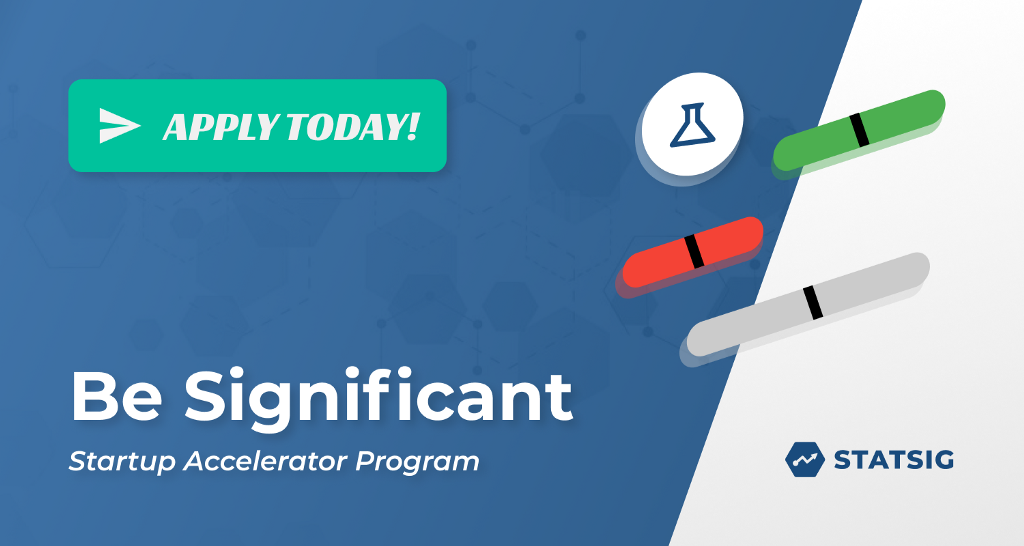
Welcome to Statsig’s Startup Accelerator Program
Today, we’re excited to announce the Statsig Startup Accelerator Program, Be Significant, that can give your startup access to Statsig’s feature gates and experimentation platform, completely free for a full year.
If you’re with a startup that was founded less than two years ago, has raised less than $20 million, and employs less than 20 people, you can apply now today. If you don’t know whether you’re eligible, apply anyway and we’ll be in touch with you in less than four business days on a package that works for you.
It’s personal
Since we launched Statsig, we’ve worked with companies of all stages and sizes. Growing through the pains of starting from scratch ourselves has given many of us at Statsig a new perspective on the trials and tribulations of startups and young teams. The more we see our startup customers succeed, the more excited we are about empowering every product team in the world.
What hasn’t changed
While we’ve seen more unicorns than ever recently, sadly what hasn’t changed over the years is the startup failure rate. According to the U.S. Bureau of Labor Statistics, over 20% new businesses fail within 1 year, over 30% within 2 years, and about 50% within 5 years.
Startups need two things to thrive: innovation and growth. Innovating itself isn’t enough if your customers don’t use your innovation. This engagement from customers is popularly called product-market fit (PMF). According to the Startup Genome Project, lack of product-market fit is the biggest reason for early-stage startup failure.
At this stage, startups tend to take 2–3 years longer to validate the market than founders estimate. Meanwhile, in the absence of growth, lack of cash flow and fundraising challenges act as death nails in a startup’s coffin. On the other hand, startups that fail fast, learn from their mistakes, and pivot 1–2 times see 3.6x higher active user growth and tend to raise 2.5x more capital.
But why haven’t startups gotten better at validating PMF faster? One reason is the lack of data and absence of tools to mine the insights from this data.
What has changed
Fortunately, what has changed over the last decade is that the industry collectively now has a lot more experience running product experiments. Microsoft, Amazon, Facebook, Airbnb, Uber, Netflix, and Spotify have all built major in-house product experimentation platforms over the past decade.
We now also have modern cloud and data infrastructure that enables automation in computing experiment results and making these results cost-effectively available to everyone in the team.
This combination of this accumulating experience and infrastructure improvements means that running experiments no longer slows down product development. On the contrary, the experimental data builds tight feedback loops that help teams immediately measure the impact of features that they build.
This allows teams to iterate faster while making smarter decisions, ultimately unlocking product innovation at scale. In the long term, this translates into a competitive advantage. In the short term, it manifests as growth - in user engagement and business results.
Despite these improvements, there was still no trusted commercial service that teams could simply pick up and hit the ground running with product experimentation when we started Statsig in Feb 2021.
Reducing the Cost of Experimentation
At Statsig, we’re convinced that reducing the human cost of experimentation to nearly zero is essential for both product growth and long-term innovation. We already offer a service with no seat-based charges or license fees. You pay only for experiment exposures and events that you log with Statsig.
We’re thrilled to introduce Be Significant, a program designed exclusively for startups, with up to 25 million exposures/events per month for free - for a full year, no matter where in the world you are, what technology you use, or what device your application runs on.
To get started, simply apply here and signup for a Statsig account.
We’re proud to do our small part in helping enable the next generation of startups harness the power of data to invent and iterate faster. We’re also continuously expanding our getting started guides and reviewing experiments with hundreds of product teams on our Slack channel. Join us and share your product stories and experiments!